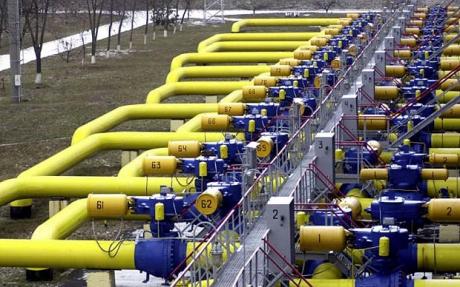
Slovakia: Potential Gateway for Reverse Gas Flows from Europe to Ukraine (Part Two)
Publication: Eurasia Daily Monitor Volume: 10 Issue: 150
By:

The European Commission encourages Slovakia to emulate Hungary and Poland transiting natural gas supplies from Western Europe to Ukraine. Such deliveries involve re-exporting gas volumes and reverse-using transit systems. Following German RWE Supply & Trading, some other European companies may well also consider selling gas to Ukraine in view of ongoing market trends (see EDM, August 12).
The Transgas pipeline, connecting Germany via the Czech Republic to Slovakia, can provide a gas transportation route from European spot markets to Ukraine. This involves (as in Hungary and Poland) adapting the existing system for bi-directional use. RWE accomplished this successfully, albeit with small volumes, for emergency supplies via the Czech Republic to Slovakia in January 2009, when Russia cut off gas supplies to Europe. Four years later, RWE sold its pipeline in the Czech Republic, Net4Gas, to a German-Canadian investors’ consortium as of March 2013.
That pipeline connects with Slovakia’s transit system, operated by Eustream, at Lanzhot on the Czech-Slovak border. To facilitate a reverse flow, west-east toward Ukraine, the Lanzhot inter-connection point has an important role to play.
Recently, however, Slovakia’s regulatory authorities and Eustream have more than trebled the tariffs at Lanzhot for gas shippers. The tariff hike affects European shippers, discouraging those interested in selling gas to Ukraine, particularly from the start of the heating season in October. Whether the sudden tripling of that tariff is based purely on commercial considerations is something that needs to be looked into more closely. The Slovakian government’s position is not clear on this matter (ICIS Heren, August 2).
Gazprom claims that Ukraine is not receiving physical gas flows via Hungary or Poland. According to Gazprom, those supplies involve Russian gas volumes that were destined for RWE, or perhaps for Hungary and Poland, but are being re-sold to Ukraine instead, without physical transfer. Gazprom surmises that those volumes are being traded back to Ukraine already during their transit or storage in Ukraine, before those volumes ever cross Ukraine’s western borders (see EDM, July 15).
Gazprom has warned of possible legal action, but such warnings sound hollow. In fact, gas deliveries to Ukraine are registered as flowing through Hungarian and Polish pipelines in the reverse mode. At present, RWE acts as the seller in all cases. The deliveries probably involve a mix of gas volumes that RWE procures from Gazprom itself (after winning discounts in arbitration court) and also on European spot markets. From both of those sources, prices are significantly lower than Gazprom’s sale price to Ukraine. Re-selling to Ukraine is consistent with the competitive gas market that the EU promotes. Meanwhile, Gazprom’s European customers can freely re-sell Russian gas to third parties. Gazprom’s supply contracts traditionally contained “destination clauses” that barred re-exports to third parties. However, growing market diversification has rendered those clauses inoperable.
Re-selling gas volumes to Ukraine while they are still in transit or storage there, i.e. resorting to virtual gas transfers, would obviously be preferable to pumping those volumes physically across the Ukraine-EU border and pumping them back. However, Gazprom insists that it owns the gas during its transit and storage in Ukraine. On this basis, Gazprom might block virtual gas transfers, insisting on physical delivery by Gazprom itself to customers in EU territory.
In that case, European companies wishing to re-sell significant portions from that flow back to Ukraine through physical transfer must do so in Slovakia. The Slovakian gas transit system, a direct continuation of the Ukrainian, carries the bulk of that flow; and the Slovakian system’s large spare capacities allow pumping significant volumes back to Ukraine. The European Commission, the Slovakian government and Eustream are exploring solutions in this vein. One solution under consideration would involve a “ringed,” or girdled, pipeline junction with bi-diretional flow (Sme [Bratislava], August 8; Nicu Popescu, “Ukraine’s Gas Loop,” EU Institute for Security Studies [ISS, Paris], July 2013).
Gas from Ukraine’s main storage sites must travel a short distance to the Ukraine-EU border through transit pipelines. Gazprom, however, may have reserved those pipeline capacities to itself in advance under the 2009 agreement. This is possibly the meaning of Gazprom’s unverified claim to be de facto operator of the Ukrainian pipeline that runs to the Slovakian border. That claim, as much else in the 2009 agreement, is obscure and subject to interpretations (Dzerkalo Tyzhnia, June 21; see EDM, July 16).
European companies operating in a depressed gas market must in some cases procure unnecessary volumes from Gazprom under “take or pay” clauses. Re-exporting some of those volumes to Ukraine, with a mark-up over Gazprom’s sale price in Europe, but still below Gazprom’s sale price for Ukraine, is a creative solution as RWE, Hungary, Poland and the European Commission have discovered; and Slovakia may follow suit.




